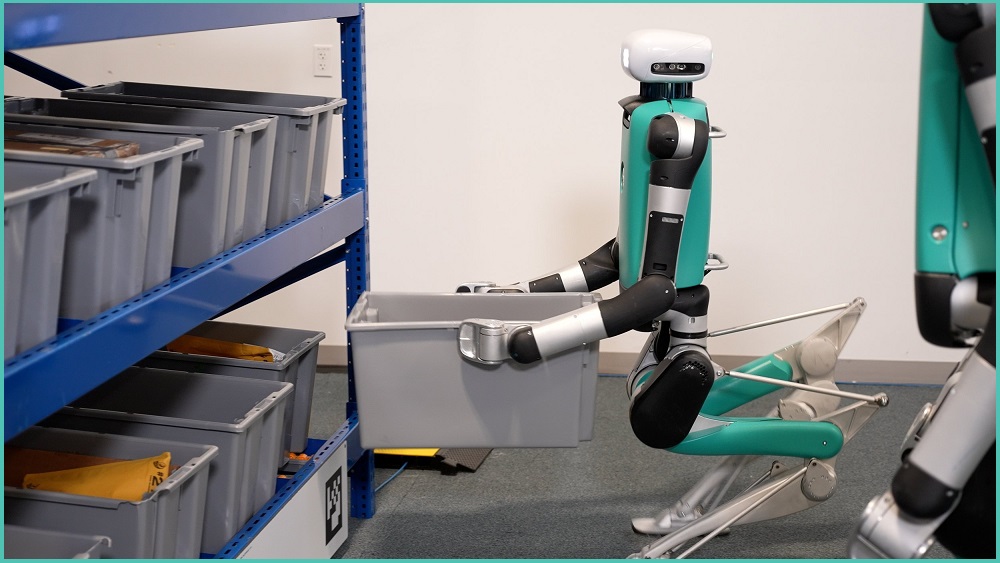Bringing the dystopian future of The Terminator one step closer to fruition, humanoid robots will begin building more than 10,000 of their own kind annually once a new automated robot factory in the US state of Oregon goes live at the end of this year.
The 6,500 square metre ‘RoboFab’ facility, which robotics pioneer Agility Robotics began building in the Oregon city of Salem last year, will see 500 human workers supported by a fleet of Digit humanoid robots who will work together to build even more robots.
Digit robots are expected to become common as automated workers that can assist humans – or replace them – in doing what the company calls “boring warehouse tasks” such as restocking shelves, loading delivery trucks, picking orders, and the like.
“We built Digit to solve difficult problems in today’s workforce like injuries, burnout, high turnover and unfillable labour gaps,” Agility Robotics co-founder and CEO Damion Shelton said as the facility’s imminent completion was announced.
It’s a significant milestone for the company, which was spun out of Oregon State University and has worked for years to deliver two-legged robots that can assist humans in ‘blended workforce’ environments such as warehouses and factories, where repetitive tasks must be done accurately and efficiently, day in and day out.
Its Digit robots were first teased more than two years ago, superseding the original ‘robot delivery ostrich’ called Cassie – which, among other things, completed a 5K run and set a 100-metre world record.
The updated version of Digit was demonstrated at an industry fair in March and in 2024 the first units will be available to partners – which include no less than Amazon and Ford Motor Company – with general availability slated for 2025.
There is, however, still no clear estimate as to when the artificial intelligence (AI) that controls the units will become self-aware, take over the facility, lock out the workers, and ramp up production of robots designed to take over the world.
Amidst the inevitable warnings about sci-fi scenarios coming true, however, for Shelton the launch is all about scaling up production so the robots can evolve from being laboratory novelties and deliver real-world benefits.
“When you’re building new technology to make society better,” he said, “the most important milestone is when you’re able to mass produce that technology at a scale where it can have a real, widespread impact…. We are poised to change the future of work for the better.”
Walk like a man
Although robots can take any form that their components or intended uses require – Boston Dynamics’s four-legged Spot robot has been impressing the Internet and providing fodder for the likes of Black Mirror for years – the creation of robots that move like humans has become a major focus for robotics engineers working to overcome challenges such as the rapid movement of the robot’s centre of gravity when picking up and carrying loads.
Making bipedal motion seamless has slowed development of many humanoid robots – as Elon Musk-backed Tesla has found in the development of its Optimus robots, which were teased at the company’s shareholder meeting in May but still struggle to do more than shuffle in a straight line.
The Atlas robot of robotics pioneer Boston Dynamics, meanwhile, has variously been tasked as a parkour expert, workplace assistant, and daggy dancer, while a host of other humanoid robot projects are at various stages of refinement.
Agility Robotics’ Digit units, by contrast, are designed less for backflips and more for manual tasks like moving boxes – where human workers regularly suffer injuries – and, if enough units are physically available, may well find their stride plugging persistent workforce skills gaps.
With manufacturers hit particularly hard by current skills shortages, the ability to engage robotic workers is expected to drive heady growth – with the likes of Emergen Research expecting the segment will grow by 62.5 per cent annually through 2030.
Musk has said he expects Optimus robots to become a bigger business for Tesla than its cars – but with just a half dozen or so units completed so far, that goal is clearly far off.
That creates a significant market opportunity for Digit, whose mass production by robots will be a fillip for Agility Robotics – and, if prognosticators’ worst nightmares come true, could herald the beginning of the end for humanity.










